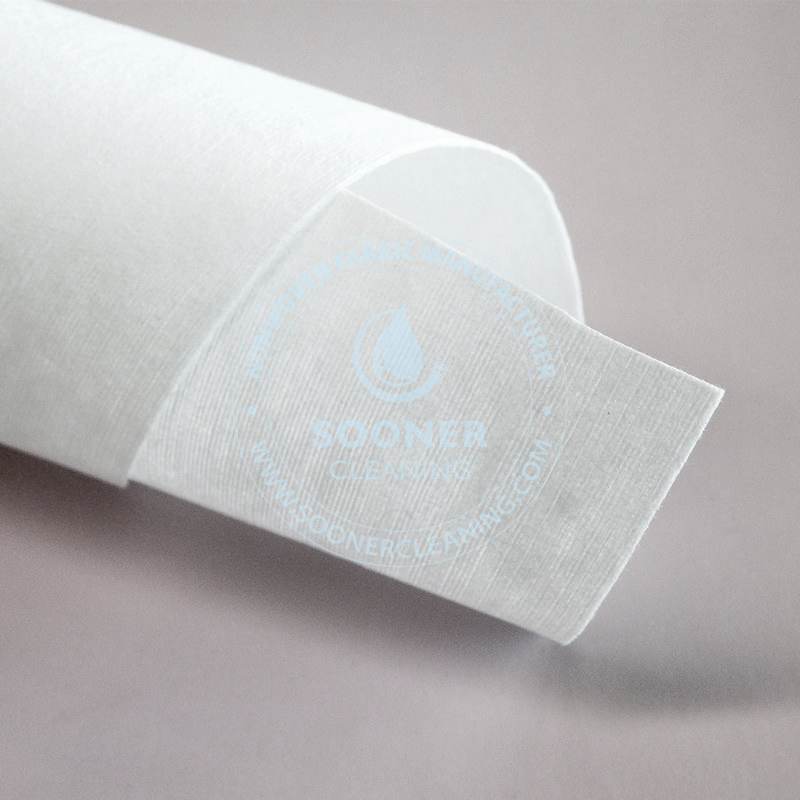As an innovative and environmentally friendly material, are starting a ‘green revolution’ in the field of wet wipes and sanitary products. This article will take you to a comprehensive understanding of this emerging material, from the basic concept to the core characteristics, from the production process to the environmental advantages, for you to open the mystery of the dispersible nonwoven fabric.

I. Definition and basic characteristics of dispersible nonwoven fabrics
Flushable Nonwoven Fabric is a specially designed nonwoven material that can be quickly dispersed and safely passed through the drainage system after flushing. It has the following distinctive features compared to conventional nonwoven fabrics:
Rapid dispersion: disperses within 30 seconds in flowing water.
Biodegradability: more than 90% naturally degradable within 90 days.
Strength balance: sufficient strength when in use, quickly weakened when exposed to water.
Plumbing safety: no clogging of drains.
This material is a perfect solution to the traditional wet wipes ‘can not be flushed’ environmental problems, is becoming a new favourite of personal care products.
II.the core material composition of flushable nonwoven fabrics
The material formula of flushable nonwoven fabric is the key to determine its performance, which mainly contains three categories of materials:
1. Main fibre materials
Special Functional Fibres: PLA polylactic acid fibres.
2. Eco-friendly bonding systems
Plant-based adhesives (e.g. starch derivatives).
Water-soluble polymers (e.g. PVA).
Bio-enzyme treatment technology.
3. Functional additives
Biodegradable wet strength agents.
Natural antimicrobial ingredients.
pH adjusting agents.
This scientific ratio ensures that the material maintains its strength during use and decomposes quickly after dispersal.
III.Production process of dispersible nonwoven fabrics revealed
The production process of dispersible nonwoven fabrics is significantly different from that of traditional nonwoven fabrics, mainly adopting the following special processes:
1. Wet process of forming a network
The fibres are suspended in water to form a uniformly dispersed slurry, which is dewatered and shaped through a special forming net. This process can:
Achieve random three-dimensional arrangement of fibres.
Obtain a more uniform product structure.
Facilitate the control of the dispersion properties of the product.
2. Hydroentanglement
The fibre network is entangled and reinforced using a high-pressure micro-fine water stream, characterised by:
No chemical adhesive is used.
Fibre bonding points are easily unravelled when exposed to water.
The product is softer and more skin-friendly.
3. Biological enzyme treatment
The use of biological enzymes such as cellulase at the finishing stage can:
Moderate weakening of fibre bonds.
Increase the speed of dissipation.
Maintain dry strength.
IV.Analysis of the environmental advantages of dispersible nonwoven fabrics
Compared with traditional materials, dispersible nonwoven fabrics have multiple advantages in terms of environmental protection:
1. Reduced pressure on sewage treatment
Fast dispersal speed (dispersal starts within 30 seconds in laboratory tests).
No clogging of pipes with the ‘wipes monster’.
Passes standard drainage system tests (e.g. INDA/EDANA GD4).
2. Reduced environmental load
Biodegradation rate >90% (90 day test).
Carbon footprint reduced by 30-50%.
25% reduction in water consumption for production.
3. Resource Sustainability
Main raw materials from sustainable forestry.
Production energy consumption reduced by 20 per cent.
Can be processed with composting system.
V. Application areas of dispersible nonwovens
This environmentally friendly material has already made its mark in a number of areas:
Personal care products.
Flushable wipes (largest share).
Feminine hygiene products.
Baby care products.
Medical
Flushable Medical Wipes.
Disposable surgical products.
Household Cleaning
Toilet Bowl Cleaning Wipes.
Kitchen Degreasing Wipes.
Industrial Applications
Biodegradable Industrial Wipes.
Environmentally friendly packaging materials.
VI.How to identify the real dispersible non-woven fabrics?
There are some ‘pseudo-flushable’ products in the market, consumers can identify them by the following methods:
See the certification mark: look for INDA/EDANA dispersible certification.
Dissolution test: Shake the bottle with water and observe the dispersion.
Check the ingredient list: it should be clearly marked ‘dispersible’ and the main fibre components.
Recognise the brand: choose the well-known environmental protection brand products.
VII.Future development trend
The technology of dispersible nonwoven fabrics is still developing rapidly, and the following trends will be presented in the future:
Performance improvement: develop new materials with both high strength and fast dispersibility.
Cost optimisation: price reduction through large-scale production.
Application expansion: penetration into more fields.
Improvement of standards: Establishment of a globally unified dispersible standard system.
With technological advances and tightening of environmental regulations, dispersible nonwovens are expected to become the mainstream hygiene materials in the next 5-10 years, making an important contribution to the global environmental protection cause.

